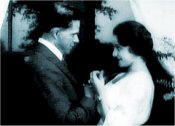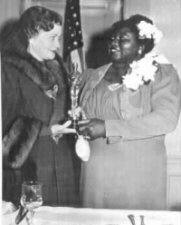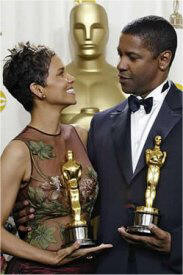
Midnight Ramble, Hollywood Shuffle:
A Look At Black Hollywood and the Oscars
By John L Gibbon
When the nominations for the 77th annual Academy Awards were announced on the morning of January 25, 2005 once again Oscar history was made when the Academy recognized the work of black performers, selecting a record five nominees. This should not sound like such a magnificent announcement, however since the Academy Awards were initiated in 1927, only a very small number of black performers have had the honor of receiving a nomination.
From the earliest days of the motion picture industry, when movies were nothing more than a gentleman’s novelty, black characters have continually appeared in many a Hollywood production. However, the hiring of black performers was rare. When feature films contained black character roles, the film’s producers consistently employed white actors, and permitted the portrayal of the character in “Blackface”.
Ironically, Bert (Egbert Austin) Williams, one of the first black superstars of popular entertainment, performed in traditional blackface makeup. He appeared in a starring role in Darktown Jubilee (1914), now considered one of the first of starring roles for blacks. Actor Sam Lucas is worth recognizing as the first African-American actor to have a lead role in a movie without hiding his true identity, in Uncle Tom’s Cabin (1914).
 |
|
Oscar Micheaux's Within Our Gates (1919) |
Movies were still a growing art form, so when Birth of a Nation was released in 1915, it was considered a masterpiece of conception and structure. However, D. W. Griffith’s masterpiece was and remains the most racist film masterpiece ever produced. Black communities were outraged that Hollywood would allow such a negative portrayal to be presented onscreen. Soon after, small studios such as Lincoln Pictures (started by actor Noble Johnson) began making films as an attempt to dismantle the existing stereotypes of Black Americans. The black film industry operated as an unseen parallel to that of its white Hollywood counterpart in a period from World War I through the 1940's, commonly referred to as the Midnight Ramble. Many of the films made during this timeframe were a direct product of segregation in the film industry. Films contained controversial racial messages aimed at empowering black communities, but were of very poor quality, never reaching an editing room or a glamorous movie house. These race movies would show in highly populated black urban areas for a short time, but were made on shoestring budgets with financing that was close to nothing. African American filmmaker Oscar Micheaux responded to the desire for unity within the black community as well as to the stereotypes in early films. Micheaux released a film that would showcase African Americans in a positive light as well as confront timely racial issues. The release of Within Our Gates (1919) was considered monumental at its time, although it included a controversial lynching sequence. Regarded as a defiant answer to Griffith’s Nation, Micheaux’s film played a very integral part in the advancement of race movies. Oscar Micheaux would become a highly respected director in the “underground” development of films; most actors in his work agreeing to surrender pay but not the message of the film. With the approach of the Jazz Age and the invention of the “talkie”, change was about to come in Hollywood.
The Jazz Singer (1927), the first major release with audible dialogue, featured a popular rendition of Al Jolson in blackface, and was surprisingly accepted by black performers. Shortly after, the “Our Gang” comedy series entered into public consciousness featuring a young group of children, including black child actors Allen Clayton Hoskins (Farina), and Sammy Morrison (Sunshine), who were as much an accepted part of the gang as were the white children. Motion pictures were beginning to include African-American actors in major character roles. The first Hollywood film to feature an all black cast was Hearts in Dixie (1929), featuring notable black actor Stepin Fetchit. Famed director King Vidor’s first talking picture, Hallelujah, about a black cotton worker who accidentally kills a man and then decides to become a preacher, was also released in 1929 by studio powerhouse MGM. It too featured an all black cast.
Other early screen successes came from African-American actors like Paul Robeson, who starred in the 1933 screen version of Eugene O’Neill’s play The Emperor Jones. Louise Beavers and the lovely Fredi Washington starred in Imitation of Life (1934) as a maid and her daughter in a stirring, powerful story of race relations, also starring Claudette Colbert. Tap dancer Bill (Bojangles) Robinson was featured in the Shirley Temple film The Littlest Rebel (1935). Nonetheless, even with these strong beginnings in the motion picture industry, controversy and racial issues still invaded the Hollywood mainstream. No one could have predicted that a sweeping story of the Civil War South would have yielded as much attention as it did when it was released in 1939.
 |
|
Hattie McDaniel receiving her Oscar for Gone With The Wind. |
Hailed as one of the greatest pictures in the era of Hollywood, Gone with the Wind was scorned by the black community for its anti-black undertones. It is a known fact that Hattie McDaniel and the other black actors in the film could not attend the star-studded premiere in Atlanta in 1939 due to the rigid segregation in the South. So as not to put director David O. Selznick in the awkward position of having to fight for her right to attend, McDaniel wrote to him, saying that she would be "unavailable". In spite of Southern law and the backlash Gone with the Wind received, Hattie McDaniel would make history in Hollywood as the first African-American actor to earn an Oscar nomination, nominated for Best Supporting Actress. Later winning the gold statuette, she gave her speech, weeping tears of joy and welcoming the loud applause.
Ever since that historical night, the door of recognition has been opened slowly by the Hollywood elite. In 1954, Dorothy Dandridge appeared in the all-black production of Carmen Jones in the title role. Her acting and dedication was so dazzling in that picture that she became the first African American woman to be given an Academy Award nomination for a significant leading role, but lost out to Grace Kelly in The Country Girl.
A young Sidney Poitier was the first African-American actor nominated for Best Actor for his role in The Defiant Ones (1958), as an escaped convict shackled to Tony Curtis, on the run in the Deep South. Despite their racial antagonism, the two develop an unexpected loyalty as they struggle together to survive. Poitier had broken through stereotypical boundaries with his work and was well on his way to acclaimed stardom. Poitier's performance in the inspirational 1963 drama Lilies of the Field earned him the Academy Award for Best Actor – the first time that prize had ever gone to an African American. Poitier’s career peaked in 1967, starring in three box-office triumphs: Guess Who’s Coming to Dinner as the handsome suitor who challenges potential in-laws Spencer Tracy and Katharine Hepburn to reconsider their attitudes toward blacks; To Sir With Love as a teacher in a rough London school who gradually gains the respect of his working-class students; and the spectacular social drama, In the Heat of the Night as the level headed police detective Virgil Tibbs, opposite Rod Steiger’s redneck Southern cop. In a year that In the Heat of the Night earned five Oscars including the coveted Best Picture award, and most of Poitier’s co-stars of Guess Who’s Coming to Dinner garnered acting nominations and won, Poitier went surprisingly un-recognized by the Academy.
Despite the oversight by the Academy of Poitier’s later work, Hollywood has been less blind and more open to the contributions given to the film establishment by noteworthy black performers since the end of the 1960’s. In fact, in closing out the decade, a little-known, seldom-seen actor, Rupert Crosse, earned the distinction as the first black performer to receive a nomination as Best Supporting Actor, nominated for his role as Ned in The Reivers (1969) opposite renowned Hollywood talent, Steve McQueen.
For the first time in Academy history, in 1972, three of the Best Actor and Best Actress nominees were black performers - Diana Ross (in her acting debut) in Lady Sings the Blues (1972), depicting the life of Billie Holiday, and Paul Winfield and Cicely Tyson in the brilliantly moving family drama Sounder (1972).
Since then, the black presence has seen a meteoric rise in Hollywood productions and Oscar-nominated performances. In the 1980’s, the Academy bestowed an amazing eleven nominations upon The Color Purple (1985), acknowledging three acting roles, including a then-unknown Whoopi Goldberg and talk-show queen Oprah Winfrey. However, such an unforgettable picture - helmed by the distinguished Steven Spielberg - failed to take home one trophy on Oscar night. On the other hand, the Academy did grant a number of notable black performers exceptional acclaim for their work.
Appearing as the tough-as-nails sergeant with a heart, Louis Gossett, Jr. won the Oscar for Best Supporting Actor in 1982’s memorable love-story, An Officer and a Gentleman, also starring Richard Gere. Later in the decade, actor Morgan Freeman was considered twice, once for his supporting role in Street Smart (1987) and once for his leading portrayal in Driving Miss Daisy (1989).
Denzel Washington, one of the most exciting actors onscreen today, made a quick name for himself in the 1980s. He earned his first Academy Award nomination, in the Best Supporting Actor category for his portrayal of Steven Biko in Cry Freedom (1987) and won the Supporting Actor Oscar two years later for his resonant performance as a reluctant Negro soldier in Glory (1989).
Washington’s natural acting talents propelled him to a leading man in the 1990’s, starring in such films as Philadelphia (1993) and Courage Under Fire (1996). However, his greatest accolades of the decade came from his rich interpretations of real-life heroes. His the famous black activist Malcolm X (1992) and boxer Rubin “Hurricane” Carter in The Hurricane (1999) garnered two nominations in the category of Best Actor.
The '90s also brought the first black director nominee, John Singleton, for Boyz N the Hood (1991), a poignant tragic film about South Central Los Angeles gang violence. His nomination also made him the youngest director nominee on record at 24 years of age. A star of that film, Cuba Gooding Jr., later went on to capture the Academy Award for Best Supporting Actor for his unforgettable role as football player Rod Tidwell in the 1996 feel-good movie Jerry Maguire.
 |
|
Halle Berry and Denzel Washington at the 2002 Academy Awards. |
The new century has already begun on a positive note. The morning after the 74th annual awards presentation of the Academy of Motion Picture Arts and Sciences (2002), the huge headlines in the papers declared history had been made. Denzel Washington (nominated for a 5th time) was named Best Actor (for Training Day, beating out Will Smith, nominated for his brilliant work in Ali) and Halle Berry Best Actress (for Monster's Ball) in an evening hosted by Whoopi Goldberg and featuring an Irving J. Thalberg honorary statue to Sidney Poitier. Berry's tearful reaction to her award spoke volumes to the burdens Hollywood once placed on the shoulders of black performers. Berry indeed had taken a challenging, diverse role and became the first African American actress to be singled out for an award in the category of Best Actress. Washington’s win as Best Actor was the first since Poitier walked away with the gold statue for Lilies of the Field. Given Denzel Washington’s prior acting history, his role as a crooked cop was against type, and he deservedly took home the prize. With his win, Washington also became the first black actor to win two Academy Awards.
Now in 2005, a year after the first West African-born actor was considered for an Oscar, history is made yet again. Actors Don Cheadle (for Hotel Rwanda) and Jamie Foxx (for Ray) were nominated for Best Actor. Foxx earned another nomination, as Best Supporting Actor for Collateral, co-starring opposite Tom Cruise, and Morgan Freeman was nominated a fourth time for his role in Clint Eastwood’s Million Dollar Baby. Lastly, Sophie Okonedo was nominated for Best Supporting Actress in Hotel Rwanda. Jamie Foxx (who once starred in comical fare like Booty Call) will be remembered as the first black to debut as a nominee in two categories in the same year, lead and supporting. He has also become the tenth performer overall to accomplish such a feat as getting nominated in both acting categories in the same year, last achieved in 2002 by Julianne Moore.
When all the envelopes are opened and the lights are shut off on another Oscar night, no matter who wins or loses, history for the black performer will have reached its highest pinnacle. Has progress come full circle? Has Hollywood learned a great lesson in understanding what has happened in the past century – black performers indeed have talent? One only needs to look to the stars like Samuel L. Jackson (nominated for his role in 1994’s Pulp Fiction), Laurence Fishburne, Forest Whitaker, Thandi Newton, Whoopi Goldberg (won the Oscar for her performance in 1990’s Ghost) or Halle Berry and remember the faces of those who came before like Ossie Davis, Lena Horne, Madame Sul-Te Wan and Noble Johnson to know the answers.